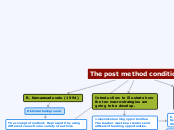The post method condition
B. Kamaravaduvelu (1994)
Historical background
The concept of method: He present it by using different views from a variety of authors.
Introduction: to illustrate how the ten macro-strategies are going to be develop.
1.maximize learning opportunities: The teacher must be a creators and utilizers of learning opportunities.
2. Facilitate negogciated interaction: Learner-learner, learner-teacber interaction
3. Minimize perceptual mismatches: there are at least 10 potential sources of perceptual mismatch.
4. Activate intuitive heuristics: provide enough textual data
5. Foster language awareness: combine the notions of consciosness -raising (Rutherford, (1987)
6. contextualize linguistic input: Syntactic, semantic, pragmatic and discourse phenomena
7. integrate language skills: Active-speaking and writing. Pasive-listening and reading.
8. Promote learners autonomy: Metacognitive, cognitive, social, and affective strategies.
9. Raise cultural consciousness: Culture teaching-awareness.
10. Ensure social relevance: Sensitive to the societal, political, economic and educational environment.
What is it? it is an idea that force us to refigure the relationship between the theorizers and the practitioners.
Characteristics
I. Search for an alternative method: out of the inherent contradictions between method as conceptualized by theorists and mehtod as actualized by practitioners has emerged a need to look beyond the notion of method.
II. Teacher's autonomy: act, know, independent knowledge.
III. Principled pragmatism: has long support to overcome the limitations of any given method.
